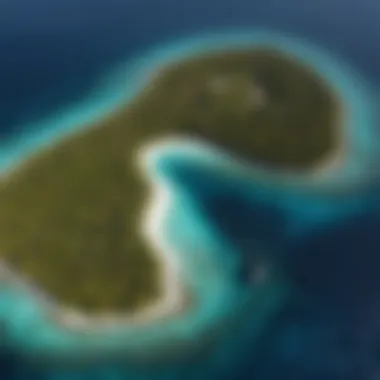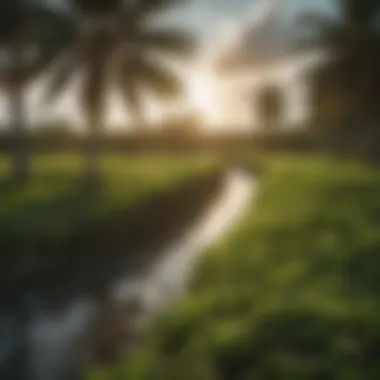Exploring Meemu Atoll: Biodiversity and Significance


Intro
Meemu Atoll is not just another location in the Maldives; it is a significant site offering insights into ecological diversity and cultural history. This atoll serves as both a physical and metaphorical gateway into the delicate balance of marine and terrestrial ecosystems. With its unique geographical features and rich biodiversity, Meemu Atoll stands as a testament to the intricate connections between culture, agriculture, and sustainable tourism.
In understanding Meemu Atoll, it's crucial to examine several key factors that define its significance. The atoll has been shaped by various environmental forces over millennia, resulting in a unique habitat for a variety of flora and fauna. More than just an ecological hotspot, Meemu also encapsulates cultural narratives and local traditions that blend harmoniously with its natural landscape. The rising emphasis on sustainable practices in farming and eco-tourism further complements its importance in today's world.
This article aims to provide an in-depth examination of these elements, delving into various aspects of Meemu Atoll. By focusing on geographical, ecological, and socio-economic factors, we can understand the implications for sustainable agriculture and conservation efforts in the area.
Geography of Meemu Atoll
The geography of Meemu Atoll serves as a foundation for understanding its ecological and cultural significance. This atoll is not merely a cluster of islands; it is a dynamic environment where land meets sea, creating unique ecosystems and opportunities for sustainable practices. The spatial characteristics and geographic formation influence not just biodiversity but also the livelihood of local communities. Thus, understanding its geography is crucial for anyone looking to explore its diverse offerings.
Location and Size
Meemu Atoll is situated in the central region of the Maldives, a collection of 26 atolls in the Indian Ocean. It lies roughly 120 kilometers south of the capital city, Malé. The atoll covers an area of approximately 30 square kilometers, which includes several islands, with both inhabited and uninhabited sections. The unique positioning of Meemu Atoll allows it to benefit from the rich currents of nutrient-filled waters, playing a vital role in supporting marine life, which is fundamental for both ecological balance and local economies.
The atoll consists of sandy beaches surrounded by coral reefs. These reefs are not only crucial for marine biodiversity but also play a significant role in protecting the islands from erosion and storm surges. The geographical layout creates small lagoons in between the islands, further enhancing the aquatic biodiversity and providing thriving habitats for numerous species.
Formation and Structure
Meemu Atoll's formation is a classic example of coral atoll development. It is believed that these islands were formed through volcanic activity millions of years ago. As the volcanic islands eroded, coral reefs began to grow around their bases. Over time, sedimentation and coral growth continued to shape the atoll into the distinct ring structure seen today.
The structure of the atoll includes elevated islands known as "habitats" and deeper lagoon areas that serve as nurseries for fish and other marine life. Coral reefs encircle the atoll, which consist of diverse types of hard and soft corals, essential for various marine species. Within these ecosystems, one can find numerous species of fish, mollusks, and invertebrates that thrive in this unique environment.
Understanding the structure and formation of Meemu Atoll is essential for conservation efforts.
In summary, the geography of Meemu Atoll is complex and multi-dimensional. Its location, size, and structural formation provide the basis for rich biodiversity and sustainable livelihood opportunities for local communities. The significance of this atoll extends beyond its natural beauty; it is a hub for ecological richness that deserves attention and preservation.
Biodiversity in Meemu Atoll
Biodiversity is crucial for the overall health and sustainability of Meemu Atoll. This extensive diversity influences ecological balance, supports livelihoods, and provides resilience against environmental changes. Understanding the unique biodiversity found in this region helps highlight the interconnections between various species and their habitats. The atoll is home to numerous species, both terrestrial and marine, each playing an essential role in their respective ecosystems. This section delves deeper into the marine ecosystems and terrestrial flora and fauna that characterize Meemu Atoll.
Marine Ecosystems
Meemu Atoll is ringed with vibrant coral reefs, which serve as critical hubs for marine biodiversity. The coral reefs provide habitats for a multitude of marine species, including fish, mollusks, and crustaceans. These ecosystems are not only stunning to observe but also play a key role in supporting local fisheries and protecting coastlines from erosion.
The health of these marine ecosystems is directly linked to the overall well-being of the communities that depend on them.
Key components of the marine ecosystems include:
- Coral Species: Coral polyps are essential for reef building, contributing to complex structures that house diverse marine life.
- Fish Populations: Various species of fish thrive among the reefs, providing food and income for local fishermen.
- Invertebrates: Organisms such as sea urchins, starfish, and crustaceans are vital for nutrient cycling and are indicators of ecosystem health.
Protecting these ecosystems is paramount, especially in the face of climate change. Increased water temperatures, ocean acidification, and pollution pose significant threats to the delicate balance of marine life.
Terrestrial Flora and Fauna
On land, Meemu Atoll features a variety of flora and fauna adapted to the unique environment. The vegetation primarily includes coconut palms, which are pivotal for local agriculture and culture. These trees not only provide coconuts for consumption but also are vital for traditional crafts and construction.
The atoll's terrestrial fauna is less diverse than its marine counterpart but equally important. Birds, including various species of sea birds, and insects contribute to pollination and seed dispersal.
Notable terrestrial elements include:
- Coconut Trees: These palms are integral to the local economy, serving as a source of food, materials, and income.
- Bird Species: Birds contribute significantly to the ecosystem, promoting seed dispersal and maintaining the ecological balance.
- Endemic Species: Unique species that exist only in this geographic area highlight the ecological significance of the atoll.
Protecting terrestrial biodiversity ensures the resilience of the ecosystem against changing environmental conditions. Conservation efforts are vital to safeguard these unique plants and animals, along with their habitats.


"Biodiversity sustains ecosystem productivity, ensures resource availability, and supports ecological balance, essential for life on Meemu Atoll."
Maintaining the integrity of both marine and terrestrial ecosystems is necessary for future generations. The conservation of biodiversity in Meemu Atoll will continue to be a vital consideration in the realms of scientific research, sustainable practices, and environmental resilience.
Human Settlement and Culture
Human settlement and culture in Meemu Atoll hold a vital place in understanding the socio-economic landscape of the region. The community life reflects a blend of tradition and modern influences. This section aims to provide an overview of the demographics of the atoll and shed light on its cultural practices, emphasizing their significance in the context of the atoll's ongoing development.
Demographics and Community Life
Meemu Atoll is home to a population that is predominantly composed of Maldivian people. The communities are small and close-knit, which fosters a sense of belonging among the residents. Many of the inhabitants engage in fishing and agriculture as their primary means of livelihood. The population density is relatively low compared to mainland areas, allowing for a tranquil lifestyle.
Key demographic characteristics include:
- Predominantly local Maldivians.
- Small community size with limited migration.
- Sturdy social networks based on family and tradition.
Daily life on the atoll revolves around communal activities, emphasizing cooperation and integrity. Fishing groups work together, sharing resources and knowledge to ensure sustainable practices. The sense of community is critical in building resilience against external challenges, such as environmental changes and economic pressures.
Cultural Practices and Traditions
The cultural practices of Meemu Atoll are deeply rooted in its history and environment. Festivals and traditions play vital roles in the social fabric of the community. Events like Eid and local harvest festivals are celebrated with enthusiasm. These gatherings foster unity, showcasing local music, dance, and crafts.
Significant cultural aspects include:
- Traditional music and dance often performed during festivals.
- Handicrafts, such as weaving and mat making, passed down through generations.
- Culinary practices that utilize local ingredients, emphasizing fresh seafood and coconuts.
The richness of Meemu Atoll's culture is not only a source of pride but also contributes to sustainable tourism, providing visitors an authentic experience.
Moreover, the local dialect reflects the identity of its inhabitants. It shares similarities with other Maldivian regions while holding unique phrases and expressions. Understanding these cultural nuances can greatly enhance interactions between locals and visitors, fostering respect and appreciation for the atoll's heritage. Through cultural preservation, the residents of Meemu Atoll maintain a connection to their ancestors while adapting to modern influences.
Economic Activities
Understanding the economic activities in Meemu Atoll reveals the practical applications of its natural resources and cultural heritage. These activities not only support the local economy but also play a pivotal role in maintaining the sustainable practices essential for the region's preservation. The integration of fishing and agriculture into a cohesive economic strategy is vital. Fishing dominates the local economy, while innovative agricultural practices are being adopted to enhance food security and independence. This article now explores both fishing and agricultural practices in detail.
Fishing and Marine Resources
Fishing forms the backbone of the Meemu Atoll's economy. The surrounding waters are rich in diverse marine life. This abundance provides food and livelihoods for local residents. Different fishing methods are practiced, including traditional artisanal fishing and more modern techniques. Many locals rely on methods that are sustainable, minimizing the impact on marine ecosystems.
Local fishermen target species like tuna and snapper. Sustainable Management of fish stocks is crucial here. Programs aimed at regulating fishing seasons and catch limits are emerging. These programs help prevent overfishing and ensure long-term availability of resources.
Benefits of responsible fishing include:
- Economic stability: The income generated helps families meet daily needs.
- Cultural preservation: Fishing traditions strengthen community bonds.
- Biodiversity protection: Sustainable methods safeguard marine life for future generations.
Agricultural Practices on the Atoll
Agricultural practices on Meemu Atoll are evolving. Given the unique environmental conditions, including sandy soil and limited freshwater, farmers have adapted various techniques. These methods are innovative and focus on sustainability. The primary crops include taro, coconut, and vegetables that thrive in the atoll's ecosystem.
Important elements of agriculture here include:
- Rainwater harvesting: Farmers collect rainwater for irrigation, conserving precious resources.
- Intercropping systems: Growing multiple crops together enhances soil health and yields.
Research institutions are increasingly interested in these practices. Studies focus on sustainable horticulture that can combat climate challenges. Engaging local farmers in these research opportunities results in shared knowledge and benefits.
"Sustainable practices in fishing and agriculture are crucial for the longevity of Meemu Atoll’s resources and the well-being of its community."


These considerations make it clear that economic activities are intertwined with environmental and cultural significance.
Tourism Industry
Tourism is a vital part of the economy in Meemu Atoll. It generates significant revenue and supports local employment. The natural beauty and biodiversity attract numerous visitors each year. Understanding tourism's role helps in addressing its benefits and challenges. People come for pristine beaches, vibrant coral reefs, and rich cultural experiences. This section covers sustainable practices, potential environmental impacts, and recommendations.
Sustainable Tourism Practices
Sustainable tourism in Meemu Atoll focuses on minimizing negative impacts while enhancing visitor experiences. Various practices are in place to protect the environment and resources.
Some key practices include:
- Conservation of Marine Life: Tour operators are encouraged to follow guidelines that protect coral reefs and marine ecosystems. Snorkeling and diving activities often emphasize awareness of marine habitats.
- Local Community Engagement: Collaborations with local communities promote cultural heritage and traditional crafts. Tourists can enjoy authentic experiences while supporting artisans.
- Waste Management Initiatives: Hotels and resorts implement recycling programs and educate guests on waste reduction. These efforts aim to keep the atoll clean and maintain its charm.
- Eco-friendly Accommodations: Staying at environmentally conscious lodgings helps minimize the carbon footprint of tourism. These places use renewable energy and sustainable materials.
By adopting such practices, Meemu Atoll's tourism sector can thrive without compromising its natural and cultural treasures.
Impact of Tourism on Local Environment
While tourism brings benefits, it also poses risks to the delicate environment of Meemu Atoll. Understanding these impacts is essential for sustainable development.
Key environmental impacts include:
- Coral Reef Damage: Increased tourist activities can lead to physical damage to coral reefs. This is often due to careless snorkeling or anchoring of boats, which harms underwater ecosystems.
- Pollution: The influx of tourists can result in pollution from waste and litter. Proper disposal systems are necessary to manage the increased waste from visitors and businesses.
- Resource Depletion: Tourism puts a strain on freshwater resources. High demand can lead to over-extraction and affects local agriculture, creating a conflict between tourism and farming needs.
- Ecosystem Disruption: Construction of resorts and infrastructure can disturb local wildlife habitats. Additionally, invasive species may be introduced through tourism, threatening native flora and fauna.
To mitigate these impacts, it is crucial to establish regulations. These include visitor limits, proper waste disposal methods, and habitat protection initiatives.
In summary, by implementing sustainable practices, Meemu Atoll can maintain its ecological integrity while still reaping the benefits that tourism offers. The balance between tourism growth and environmental protection remains an ongoing challenge, demanding the cooperation of all stakeholders.
Environmental Concerns
The environmental concerns surrounding Meemu Atoll are essential in understanding its significance and the impact it faces from various factors. The atoll's delicate ecosystems, which include diverse marine and terrestrial biodiversity, are increasingly vulnerable to climate change and human activities. Recognizing these concerns can inform better management strategies and facilitate deeper engagement with agricultural and conservation practices that protect the atoll's unique natural heritage.
Climate Change Impacts
Climate change poses a considerable threat to Meemu Atoll. Rising sea levels, a phenomenon attributed to global warming, greatly affect low-lying regions such as atolls. Some key impacts include:
- Coral Bleaching: Warmer ocean temperatures lead to coral bleaching, which can devastate marine ecosystems. The health of coral reefs directly influences fish populations and overall marine biodiversity.
- Coastal Erosion: Increased sea levels contribute to erosion of coastlines, threatening local communities and habitats. The loss of land alters ecosystems and can lead to loss of agricultural areas as well.
- Salinization: As seawater intrudes into freshwater sources, the agricultural viability of the atoll suffers. Salinity can negatively affect crops, making it imperative to seek resilient farming practices.
In summary, climate change has far-reaching consequences for both the environment and the community of Meemu Atoll. Adapting to these changes is crucial for the survival of its ecosystems and the well-being of its inhabitants.
Conservation Efforts
To address the environmental concerns faced by Meemu Atoll, various conservation efforts are being implemented. These initiatives aim to protect biodiversity and ensure sustainable agricultural practices. Some notable efforts include:
- Protected Areas: Establishing marine protected areas helps safeguard critical habitats and enhances ecosystem resilience. Regulations concerning fishing and tourism in these zones are vital for maintaining biodiversity.
- Reef Restoration Projects: Active restoration of coral reefs has gained traction. Techniques such as coral farming and transplantation can help revive damaged reefs and foster a more resilient underwater environment.
- Education and Community Engagement: Local communities play a significant role in conservation. Programs that educate residents on sustainable practices and environmental stewardship can lead to greater awareness and involvement in protecting their surroundings.
"Conservation is not just about protecting nature; it's about ensuring the future of agriculture and fisheries that communities depend on for survival."
Overall, conservation efforts in Meemu Atoll reflect a balanced approach to environmental challenges. Through careful planning and cooperation among stakeholders, it is possible to enhance the atoll's resilience against ongoing threats, while still allowing for economic activities that support local livelihoods.
Agricultural Innovations
Agricultural innovations are crucial for sustainable development, particularly in a unique environment like Meemu Atoll. These innovations enable local farmers to adapt to the challenges posed by geographical and climatic dynamics. As this region faces specific constraints, the ability to implement innovative farming techniques not only sustains the local economy but also promotes ecological balance and resilience.
Techniques Adapted to the Atoll Environment


Meemu Atoll presents distinct challenges for agriculture due to its saline soil and limited freshwater resources. To overcome these hurdles, farmers have developed several techniques tailored to these conditions. Some important practices include:
- Salinity Management: Farmers utilize salt-tolerant plant varieties. These plants, such as coastal rice and certain types of vegetables, are cultivated to thrive in saline conditions.
- Hydroponics: This soilless farming method has gained popularity. Utilizing nutrient-rich water, hydroponics allows for efficient use of space and resources, thus making it viable for the atoll environment.
- Rainwater Harvesting: Given the scarce freshwater supply, rainwater harvesting systems are implemented. This technique captures and stores rainwater for agricultural use, thereby reducing pressure on limited groundwater sources.
These techniques illustrate how innovation is not just a choice but a necessity for farmers in Meemu Atoll, ensuring sustainable agricultural practices.
Research in Sustainable Horticulture
Research in sustainable horticulture plays a significant role in enhancing agricultural productivity and ecological viability. On Meemu Atoll, scientific inquiries are focused on finding methods that not only increase yields but also preserve the delicate ecosystem. Key areas of research include:
- Drought-Resistant Crops: Development of crop varieties that can withstand longer periods of drought is crucial. It can lead to increased food security for the local population.
- Integrated Pest Management: Utilizing biological control methods minimizes reliance on chemical pesticides. This approach can lead to a healthier environment.
- Soil Health Improvement: Studies on soil amendment techniques can enhance soil fertility and structure. For instance, organic composting and the use of green manures protect against erosion and salinity.
The importance of research in sustainable horticulture cannot be overstated. It not only contributes to agricultural productivity but also aligns with the environmental conservation goals of the region.
Research Opportunities
Research opportunities in Meemu Atoll offer critical insights into both its unique ecosystem and the adaptive strategies employed in its agriculture. Investigating these areas provides a holistic understanding that is essential for sustaining the atoll's biodiversity and the livelihoods of its inhabitants. By concentrating on ecological studies and agricultural development research, researchers can unveil new knowledge that contributes to both local practices and global theories in environmental science and agronomy.
Ecological Studies
Ecological studies within Meemu Atoll can reveal complex interactions between various species and their habitats. These studies are vital for understanding how the biodiversity of the atoll maintains ecological balance and resilience against environmental changes.
In particular, examining coral reef systems, mangrove forests, and sandy beaches can yield valuable data about marine and terrestrial life. Factors like water quality, species distribution, and the impact of climate change can be assessed through ongoing ecological research.
Key elements of ecological studies include:
- Biodiversity assessment: Documenting flora and fauna helps identify species that may be endangered or at risk.
- Habitat monitoring: Studying specific habitats aids in understanding their health and the effects of human activity or climate change.
- Ecosystem services evaluation: Assessing what ecosystem services, such as coastal protection or carbon sequestration, are being provided helps inform conservation strategies.
Engaging with local communities during these studies enhances data accuracy and builds capacity for sustainable management practices. Moreover, findings from these studies can support conservation efforts and inform policymakers about necessary regulatory actions.
Agricultural Development Research
Agricultural development research plays a crucial role in the future of food security within Meemu Atoll. Considering the atoll's limited land and freshwater resources, innovative agricultural practices can optimize food production while ensuring sustainability.
Research in this domain might focus on the following areas:
- Soil management techniques: Understanding soil health is pivotal for enhancing crop yields. Techniques such as crop rotation and organic amendments can be evaluated for their effectiveness.
- Water management strategies: Researching efficient irrigation methods can address the challenges posed by salinity and variable rainfall patterns.
- Crop diversification: Investigating alternative crops that can thrive in the atoll's unique conditions could mitigate risks associated with monoculture farming.
Additionally, integrating local knowledge with scientific research can foster community participation and enhance resilience against external shocks. By supporting farmers through tailored agricultural practices, the atoll can cultivate both economic stability and ecological balance.
"A deep understanding of both ecological and agricultural research in Meemu Atoll can unlock sustainable pathways for its future."
As researchers endeavor to explore the intricacies of Meemu Atoll, the knowledge generated will not only benefit the local community economically but also contribute to broader discussions about sustainability and conservation in similar ecosystems worldwide.
Epilogue
In summary, the exploration of Meemu Atoll is a pivotal aspect that brings forward the intertwined nature of its biodiversity, cultural significance, and economic potential. The unique characteristics of this atoll encapsulate the essence of ecological importance and sustainable practices. The findings underscore the critical role Meemu Atoll plays not only for its inhabitants but also for global biodiversity efforts. Whether through the intricate marine ecosystems or the rich agricultural practices adapted to its environment, Meemu serves to highlight the necessity of integrating sustainability into local and global contexts.
Summary of Key Findings
This article examined various facets of Meemu Atoll that contribute to its significance:
- Geographical Importance: The atoll's location in the Indian Ocean provides a vital habitat for diverse marine life.
- Biodiversity: Rich marine and terrestrial ecosystems underscore its ecological value. Various species thrive in this environment, showcasing the atoll's health.
- Cultural Heritage: The community's unique traditions and lifestyles emphasize the symbiotic relationship between the people and their environment.
- Economic Activities: Fishing and agriculture remain central to the local economy, with practices increasingly focusing on sustainability.
- Environmental Concerns: Climate change poses risks, prompting the need for concerted conservation efforts.
These points illustrate that Meemu Atoll is not merely a geographic entity; it is a vibrant ecosystem warranting ongoing focus for research and preservation.
Future Directions for Research and Conservation
Looking forward, there are several important avenues to consider for further research and conservation in Meemu Atoll:
- Ecological Research: Continued studies on the marine and terrestrial ecosystems are critical. Scientists should monitor changes due to climate shifts, assessing impacts on biodiversity.
- Sustainable Agriculture Practices: Research focused on developing innovative agricultural methods that respect the vulnerabilities of the atoll's environment is crucial. Adapting practices to safeguard against erosion and salinization will become increasingly important.
- Community Engagement: Engaging local communities in conservation efforts can bolster both ecological and cultural preservation. Education and sustainable practices initiatives can create better awareness and active participation.
- Climate Change Mitigation: Comprehensive strategies that address climate change impacts should be a priority. Collaboration with international organizations can enhance conservation efforts and resource allocations.
- Biodiversity Assessment Programs: Implementing programs that track and assess changes in species populations can provide critical data for informing conservation policies.







